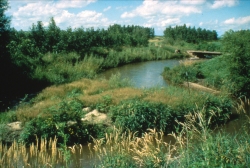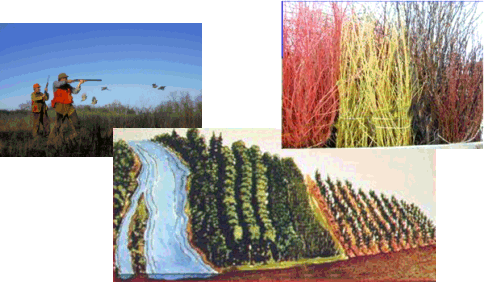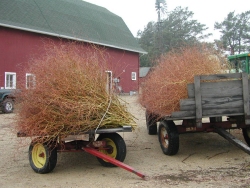Agroforestry Practices
Riparian Forest Buffers
Riparian Forest Buffers are living filters comprised of trees, shrubs, forbs and grasses, including native plants, established in distinct zones. They enhance filtration of nutrients from surface run-off and shallow ground water, and these excess nutrients are utilized for plant growth. Riparian buffers protect the water quality of streams and lakes and are an effective tool for controlling erosion and providing food and cover for wildlife. Decorative woody florals, like red osier dogwood and curly willow, and berries planted in the shrub zone provide additional income from riparian buffers. Lease hunting is another income option, as many types of waterfowl find habitat in riparian buffer systems.

|

|
| These pictures were taken at Bear Creek Watershed in Iowa upon the establishment of a riparian forest buffer. The change in four years is dramatic. | |
Riparian Buffer Success Story:

|
Ron Risdal - Corn soybean and alfalfa producer,
Story County, Iowa. Established a riparian buffer in 1990.
"I don't think we've lost hardly any stream bank since 1993, where before, we were moving the fences about every year. When it floods, the water stops at the buffer strip now instead of washing all over the bank. We don't have to move fences every year, and we don't have to haul rocks in the gullies like we used to do years ago."

|
| Riparian forest buffers provide invome potential through planting decorative woody florals in the shrub zone, as well as excellent wildlife habitat forlease hunting. |
Decorative Woody Florals: Income Potential from Riparian Buffers

|
Red Osier Dogwood and Curly Willow are examples of florist materials that can be grown for additional income in a riparian buffer practice. Woody florals can be sold to retail or wholesale florists by the stem or the bundle at competitive prices.
Learn more about decorative woody florals through research conducted by the University of Nebraska Extension Forestry Program, including a list of rootstock suppliers.

|
See the Profit in Agroforestry section for additional information about the value of woody florals.
Established riparian forest buffers protect the streambanks from soil loss due to water erosion and filter out undesirable inputs. Inputs (nutrients, chemicals) to the waterway from agricultural land are trapped by the buffer vegetation, reducing the amount of non-point source (NPS) pollution entering the stream.
Center for Agroforestry researchers and collaboarators are conducting comprehensive studies on riparian buffers and water quality. For additional information:
- View paired watershed research conducted at the University of Missouri Greenley Memorial Research Center
- Iowa State University Riparian Buffer research (UMCA collaborators)
Published works by UMCA collaborators, Journal of Environmental Quality:
- Agroforestry Practices, Runoff, and Nutrient Loss: A Paired Watershed Comparison
- Landscape and Watershed Processes
A new guide from the National Agroforestry Center provides science-based guidelines for designing buffers:
Learn more about riparian forest buffers from the following UMCA resources:

